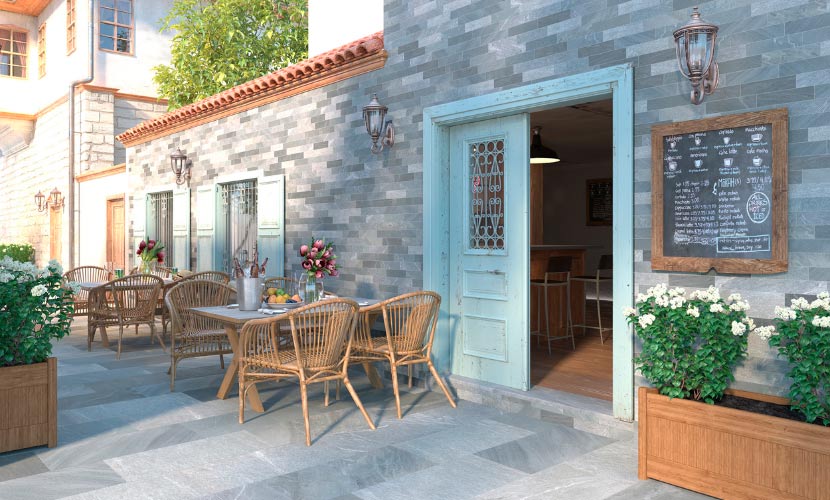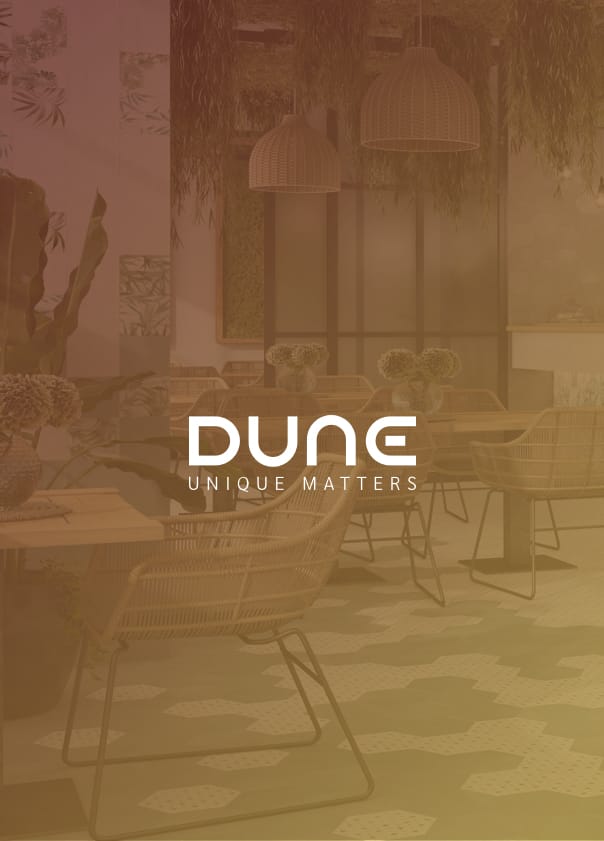Tiled façades: a collection of stylish ideas
On the one hand, façades are the calling card of any building, reflecting its architectural style, history and personality. On the other hand, it is also responsible for insulating the house from the outside and withstanding any inclement weather.
When choosing the cladding for a façade, all these factors must be taken into account and, for this reason, tiles are one of the best options. Their versatility, durability and beauty mean that they have all the right qualities for a façade. In this article, we will explore the origin of tiled facades, their benefits and their contemporary application.
Origin of façade tiles
Tiles have a long history, as they have been used since ancient Mesopotamia to decorate both walls and floors. But it was in the Iberian Peninsula where the art of façade tiles reached its peak, being especially prominent in Andalusia and Portugal.
Façade tiles in Andalusian patios
Andalusian patios are famous for their beauty and freshness, and tiles play a fundamental role in their charm. These patios, typical of Andalusian architecture, are adorned with brightly coloured tiles and geometric or floral designs, creating a unique and welcoming atmosphere.
The floors, the half-height walls and the classic Moorish-style fountains are the classic elements that draw the collective imagination when we think of Andalusian patios.

The tradition of tiles on facades in Portugal
In Portugal, tiles are also an integral part of its architecture and culture. Since the 15th century, tiles have decorated the façades of religious buildings, palaces and private homes, telling stories through their elaborate designs. This tradition endures to this day, making Portugal a sought-after tourist destination for its stunning tiled façades.
Strolling through the streets of Portugal is like walking through an open-air museum of beautiful tiled façades in all shades, but with a predominance of green, blue and ochre tones, which connect us with the sea and nature.

Façade cladding as a major design element: advantages and benefits
The use of tiles on facades is not only aesthetically pleasing, but also offers a number of practical and functional advantages. Tiles are weather-resistant, durable and easy to maintain, making them an ideal choice for façade cladding. In addition, their versatility in terms of design and colour allows for the creation of unique and personalised visual effects.
Below, we take a closer look at the advantages of using porcelain tiles on façades:
- Strength and durability. Thanks to its manufacturing process, porcelain tile is very resistant, which makes it the perfect ally for façades, as it is able to withstand knocks and any wear and tear caused by climatic changes (sun, rain, wind, etc.).
- Waterproof. Another of the fundamental characteristics of porcelain tiles after the manufacturing process is that the result is a compact, non-porous material that does not absorb water. This is essential for use on a façade, as the integrity of the tile must be maintained for many years.
- Lightweight and easy to install. It is a material that is much less heavy than other more classic materials such as stone. This also makes it easier to install on a façade and gives a lot more scope for installation.
- Wide variety of designs. Finally, it should be noted that porcelain tile can be presented in a wide variety of designs, looks, formats and finishes. In this sense, it is possible to achieve façades with tiles with the appearance of natural stone, cement, marble or finger mosaic without renouncing their performance.
Modern façade cladding ideas
Tiled façades are gaining popularity in recent times thanks to their versatility and functionality, making it possible to achieve modern and attractive façades. As we have seen, porcelain tiles offer a wide range of possibilities in terms of design, durability and strength, making it an ideal choice for residential and/or commercial projects.
Below, we will explore some inspiring cladding ideas for modern façades using tiles:
Façade with stone-effect tiles
One of the most outstanding advantages of porcelain tiles is their ability to mimic natural materials such as stone with amazing fidelity. These natural-looking tiles offer beauty and charm, but with the durability and strength of ceramic.
The stone effect finish creates warm and welcoming facades that blend harmoniously with their surroundings. Following this idea, our Pietrasanta collection was created, which imitates the genuine Cardoso stone and is designed for projects that seek homogeneity both on the outside and inside. Its In&Out potential makes it perfect for building a façade with tiles, as we can see in the image, without breaking with the rest of the project's aesthetics.

Ver esta publicación en Instagram
Moreover, its availability in three different formats makes this tile a perfect ally for façades where a touch of dynamism is desired without losing the homogeneous aesthetics of the rest of the project. In the tiled façade of this restaurant, the small piece is played with while maintaining the larger format, which allows the whole to have uniformity at the same time as achieving a more homely effect on the façade.

Endless mosaic effect for facades with dynamism
Another growing trend in tiled façades is the use of porcelain tiles that create an endless mosaic effect, creating dynamism and texture in the design. Our Kit-Kat series is perfect for this, as it is very easy to lay and can be used to cover curved areas, such as the façade shown in the image. In addition, its wide variety of colours and its two finishes make it the perfect ally to add colour to a façade and give it a personal, unique and differentiated touch from the rest.

Geometric and abstract designs: facades with tiles and personality
Another advantage of porcelain tiles is that they offer a wide variety of designs, from geometric patterns to abstract shapes. These modern, avant-garde designs can be used to create dynamic, visually striking façades that add a touch of originality and style to any building. Furthermore, geometric and abstract designs can be adapted to a wide range of architectural styles, from the more contemporary to the more traditional ones reminiscent of the Andalusian and Portuguese façades we saw at the beginning of the post.
Within the wide variety of tiles we have in the Dune catalogue, Mintons is one of our most special series, inspired by the hydraulic mosaics of the Victorian era of the 19th century.

Combination of colours and finishes
One of the greatest advantages of porcelain tiles is their availability in a wide range of colours and finishes. This allows designers to create customised and unique façades by combining different colours, textures and finishes to achieve the desired effect. From monochromatic combinations to vibrant and contrasting colour palettes, the possibilities are endless when it comes to designing facades with porcelain tiles.
In our new 2024 catalogue you will find a wide variety of porcelain tiles that can be used to create tiled façades. For example, Agadir offers a vibrant, untoned colour, which brings a transgressive beauty to create spaces where decoration is the protagonist.

In conclusion, porcelain tiles offer a variety of exciting and creative options for cladding modern façades. From geometric patterns and wood or stone effects, porcelain ceramics allow designers to explore new frontiers in architectural design and create stunning façades that are durable, functional and aesthetically appealing.

















